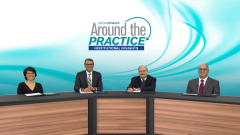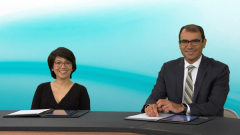
Transplant-Eligible NDMM: Optimizing Therapy for Efficacy and Tolerability
Before closing out their review of treatment for transplant-eligible multiple myeloma, panelists consider how they might adjust therapy to optimize tolerability or efficacy.
Episodes in this series

Transcript:
Alfred Garfall, MD:We’ve talked a lot about our selection of initial therapy, but initial therapy is a process. We start therapy, and we often change course along the way. Attention along the way might be more important than the initial choice because it’s not an irrevocable decision once you start. I have a fair number of patients in whom I’ve recommended adding and subtracting drugs along the way. It might be good to discuss what guideposts we’re looking for along the way, in terms of efficacy and toxicity, that might prompt us to add or subtract an agent as we go along. Sandra, could you comment a little about that? What are you looking for in those first couple of months of therapy?
Sandra Susanibar-Adaniya, MD: It would be nice if all the patients achieve the best response in the first month, but that’s not the case. We need to assess how the patient can tolerate this. Several studies have shown that the responses continue to deepen across the spectrum of induction, consolidation with transplant or not, and even the maintenance. We have patients who continue to have deeper response in their third year of maintenance. That’s been shown in the GRIFFIN trial.
We need to pay careful attention to the adverse effect profile because in the myeloma field, we’ve been blessed with a variety of tools. As we become more efficient at assessing which medication will be better for which patient, we’ve also have become better at picking up and adjusting the medications so the patient can continue to be on that and benefit from it. Just to simplify it, look at the arm of Revlimid-dexamethasone in the MAIA trial. If you compare that with the trials before that, the benefit was longer. They have longer progression-free survival and overall survival. As a community, in myeloma we’ve become better at providing better supportive care for our patients.
Alfred Garfall, MD:Thank you.
Edward Stadtmauer, MD: Al, that’s an excellent question. Sometimes, when you crack open the textbook, you’ll see doses of 25 mg of lenalidomide and twice-weekly dosages of bortezomib. Much of the success of these therapies is the long-term use of these therapies. If you generate tons of toxicity at the beginning, you’ll frequently reduce the ability. As patients become older and frailer, it’s important to think of doses and schedules that will be well tolerated and then make adjustments to increase or decrease doses and frequency. You can still have tremendously good outcomes.
Dan Vogl, MD: At the same time, if you start with a simpler regimen with triplet therapy instead of quadruplet, and you’re not seeing the response over the first 2 cycles, that indicates that the patient is likely to achieve a deep response with induction therapy. Usually, I’m looking for at least a hint of response after 1 cycle and preferably heading into at least a partial response after 2 cycles. If you’re not going to get that with your initial regimen, it’s easy to add daratumumab. Or if you’ve left out bortezomib, to add that in. If the patient is already starting to respond, you can attenuate doses to make the drugs more tolerable and make sure that you can achieve that deep response with initial therapy. That’s probably a good marker for better long-term outcomes.
Alfred Garfall, MD:Speaking to Sandra’s point about just the multiplicity of options, I have patients for whom I’ve done all those maneuvers. I’ve added daratumumab. I’ve added bortezomib in someone who has started with daratumumab and didn’t have a great response. Because we have 4-drug regimens that are safe, I’ve used them to de-intensify everything. I’ve lowered the doses of everything to make them tolerable for somebody having a hard time with a full dose of anything because of their general frailty. Some patients tolerate more complicated regimens with more drugs quite well, but when they’re given at lower doses.
Transcript edited for clarity.
Newsletter
Stay up to date on recent advances in the multidisciplinary approach to cancer.




















































































